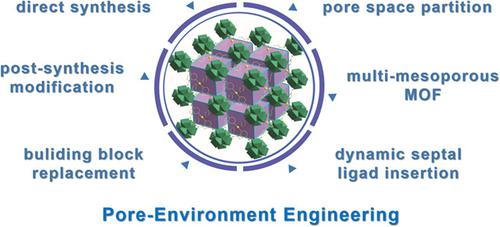当前位置:
X-MOL 学术
›
Chin. J. Chem.
›
论文详情
Our official English website, www.x-mol.net, welcomes your
feedback! (Note: you will need to create a separate account there.)
Pore‐Environment Engineering in Multifunctional Metal‐Organic Frameworks
Chinese Journal of Chemistry ( IF 5.5 ) Pub Date : 2020-03-31 , DOI: 10.1002/cjoc.201900493 Xiurong Zhang 1 , Xia Wang 1 , Weidong Fan 1 , Daofeng Sun 1, 2
Chinese Journal of Chemistry ( IF 5.5 ) Pub Date : 2020-03-31 , DOI: 10.1002/cjoc.201900493 Xiurong Zhang 1 , Xia Wang 1 , Weidong Fan 1 , Daofeng Sun 1, 2
Affiliation

|
As a new type of highly ordered porous crystalline material, metal‐organic frameworks (MOFs) have been extensively studied in many fields due to their high specific surface area and porosity, flexible modifiability and tailorability. After nearly 20 years of development, the synthesis of MOF materials has gradually evolved from exploration and trial to precise design. The synthesis method has also evolved from an early one‐step synthesis to the coexistence of various synthesis strategies, including functional‐oriented microstructural design optimization, pore size adjustment, and secondary structural unit modification, enabling MOF materials to expand their potential applications in many fields. In this review, we mainly discuss the pore regulation of function‐oriented MOF through different synthesis strategies, including (1) direct synthesis, (2) post‐synthesis modification (PSM), (3) building block replacement (BBR), (4) pore space partition (PSP), (5) construction of multi‐mesoporous MOF, (6) dynamic septal ligand insertion, and discuss the relationship between related performance optimization through framework structure and pore environment/size optimization.
中文翻译:

多功能金属有机框架中的孔隙环境工程
作为一种新型的高度有序的多孔晶体材料,金属有机骨架(MOF)由于其高比表面积和孔隙率,灵活的可修改性和可定制性而在许多领域得到了广泛的研究。经过近20年的发展,MOF材料的合成已逐渐从探索和试验发展到精确设计。合成方法也从早期的一步合成发展到各种合成策略的共存,包括功能导向的微结构设计优化,孔径调节和二级结构单元修饰,使MOF材料可以在许多领域扩展其潜在应用。在这篇综述中,我们主要讨论通过不同的合成策略,包括(1)直接合成,
更新日期:2020-03-31
中文翻译:

多功能金属有机框架中的孔隙环境工程
作为一种新型的高度有序的多孔晶体材料,金属有机骨架(MOF)由于其高比表面积和孔隙率,灵活的可修改性和可定制性而在许多领域得到了广泛的研究。经过近20年的发展,MOF材料的合成已逐渐从探索和试验发展到精确设计。合成方法也从早期的一步合成发展到各种合成策略的共存,包括功能导向的微结构设计优化,孔径调节和二级结构单元修饰,使MOF材料可以在许多领域扩展其潜在应用。在这篇综述中,我们主要讨论通过不同的合成策略,包括(1)直接合成,











































 京公网安备 11010802027423号
京公网安备 11010802027423号